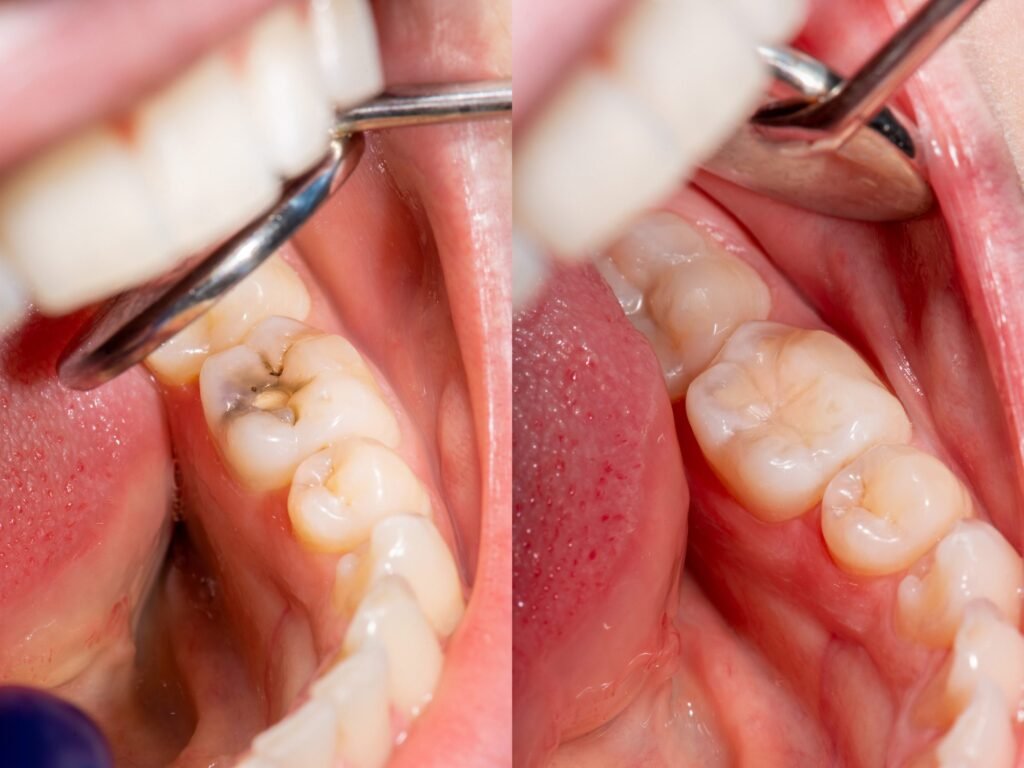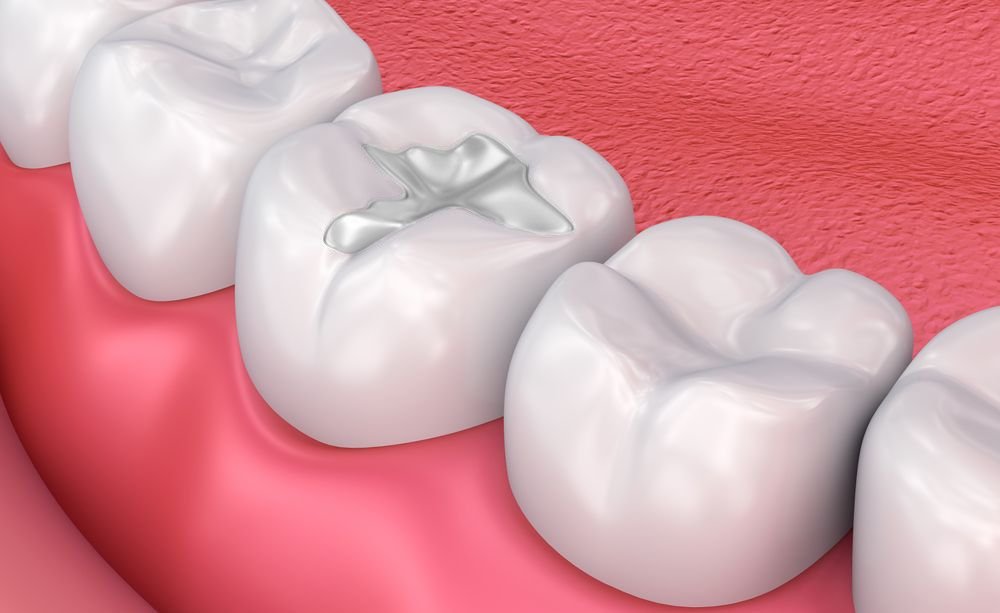Tooth Filling in Penang
Tooth Filling
Ever had that nagging toothache or noticed a small cavity when brushing your teeth? It might be time to think about getting a tooth filling. Tooth fillings are a common dental procedure designed to fix cavities and restore your tooth’s health. Whether it’s due to decay or a minor fracture, a filling can help prevent further damage and get you back to smiling confidently.
If left untreated, tooth decay and cavities can lead to more severe problems. At Chin Lim Dental, our professional tooth filling services are designed to restore the function and appearance of your teeth, helping you maintain excellent oral health.
What is a Tooth Filling?
A tooth filling is a dental procedure used to repair and restore a tooth that has been damaged by decay, wear, or minor fractures. It does this by plugging the hole in your tooth, stopping further decay.
The filling material is used to fill the cavity or damaged area, preventing further decay and restoring the tooth’s normal function and shape. When it comes to materials, there’s no one-size-fits-all solution. The type of filling that’s best for you will depend on various factors, including the location of the cavity, the extent of the damage, your dental health, and your personal preferences.
Types of Dental Fillings

Composite Resin Fillings
Composite resin fillings are made of a mixture of plastic and fine glass particles. These fillings are tooth-colored, making them an excellent choice for visible areas like the front teeth. They blend seamlessly with your natural teeth, and can be used for both small and moderate sized cavities. This type also requires less removal of tooth structure compared to other type, but is not as durable and may stain easier.
Ceramic Fillings
Tooth-colored, stain-resistant material, offering a natural appearance and durability. They can be closely matched to the color of your natural teeth, making them nearly invisible, unlike metal fillings. This makes them particularly popular for restoring front teeth or other visible areas of the mouth.They are a good and conservative choice to restore decayed back teeth but at a higher cost compared to composite fillings.
Glass Ionomer Fillings
This filling material can be matched to natural tooth color and is chemically bonded to the tooth. It is less likely to cause irritation to pulp and surrounding gum and is typically used in areas where pressure from chewing is less as it is not as strong and durable as other options.
Temporary tooth fillings can also be used in case of emergencies, where the pain is too strong and needs to be urgently dealt with. Once the pain subsides, your dentist can place a more permanent one during a follow-up appointment. You may also get a temporary filling if you’re undergoing any tooth restoration procedures to protect your tooth structure.
Benefits of Dental Fillings
Prevents Further Decay: Filling cavities stops the spread of decay, protecting your teeth from more extensive damage.
Restores Function: Fillings restore the normal function of your teeth, allowing you to chew and speak comfortably.
Improves Appearance: Tooth-colored fillings blend with your natural teeth, enhancing the aesthetics of your smile.
Long-Lasting Protection: High-quality filling materials provide durable and lasting protection for your teeth.

When Do I Need a Tooth Filling?
If you notice any of these signs and symptoms, it’s time to visit your qualified dentist for an examination.
- Toothache: A common indicator of a cavity, especially if decay has reached the tooth’s deeper layers and irritated the nerve. The pain can be sharp, throbbing, or dull, and may worsen with hot or cold stimuli.
- Sensitivity: Teeth with cavities or exposed dentin (the layer beneath the enamel) can become sensitive to certain temperatures or textures in food and drinks. You might feel sharp pain or discomfort when consuming hot, cold, sweet, or acidic items.
- Visible Decay: Look out for dark spots, discoloration, or visible pits on the tooth’s surface. These signs suggest cavities that need filling to prevent further decay.
- Cracked Tooth: A chipped or cracked tooth can expose its inner layers, causing pain, sensitivity, or even infection. A filling may be necessary to repair the damage, restore the tooth’s structure, and prevent complications.
- Worn-down Enamel: Habits like teeth grinding or consuming acidic foods can wear down tooth enamel over time. This exposes the underlying dentin, making teeth more prone to sensitivity and decay. Depending on the extent of the wear, a filling might be needed to restore the tooth’s shape and function and prevent further damage.
The Tooth Filling Process
Our tooth filling procedure is straightforward and typically completed in one visit.
Consultation
Our dentist will thoroughly examine your teeth, often using X-rays to identify the extent of the decay or damage.
Anesthesia
To ensure your comfort, a local anesthetic is administered to numb the affected area.
Decay Removal
The decayed or damaged portion of the tooth is carefully removed using specialized dental instruments.
Filling Placement
The chosen filling material is applied in layers, shaped to fit the tooth, and hardened using a special light.
The Excellence, Innovation, Trust!
Come with us for a gentle dental experience that’s straightforward, friendly, and focused on your well-being.
Our experienced team is dedicated to provide a safe and friendly experience. With our expertise and commitment to delivering exceptional results, you can trust us to help you achieve a healthy, beautiful smile that lasts a lifetime.
Expertise
Highly skilled dental team with a passion for excellence.
Latest Technology
State-of-the-art equipment ensuring precision and comfort.
Experience
With almost a decade of experience serving our communities.
Comfortable Environment
Modern and serene settings for a relaxed experience
What Our Patients Say
Tooth Fillings at Chin & Lim Dental Penang
Don’t let tooth decay compromise your oral health and smile. Contact Chin Lim Dental today to schedule an appointment for a tooth filling. Our team is here to provide you with exceptional care and restore your smile with confidence.

FAQ on Tooth Fillings
With local anesthesia, the procedure is typically painless. You may feel some pressure or mild discomfort during the process, but it should not be painful. After the anesthetic wears off, you might experience some sensitivity or discomfort, which usually subsides within a few days.
The lifespan of a filling depends on the material used and your oral hygiene practices. Composite resin fillings typically last 5-10 years, ceramic fillings 15 years or more.
Maintain good oral hygiene by brushing twice a day, flossing daily, and visiting your dentist regularly. Avoid chewing on hard objects and be mindful of foods that can stain composite fillings.
Fillings can fall out due to factors such as wear, tooth decay around the filling, or trauma to the tooth. If a filling falls out, contact your dentist as soon as possible to have it replaced.
Common side effects include temporary sensitivity to hot and cold, discomfort around the filled tooth, and minor allergic reactions to the filling material (rare). In some cases, the filling might need adjustment if it affects your bite.
You should wait until the local anesthetic wears off before eating to avoid biting your tongue or cheek. For composite resin fillings, you can eat and drink immediately after the procedure.
Signs that a filling may need replacement include tooth pain, sensitivity, visible cracks or wear in the filling, and decay around the filling. Regular dental check-ups will help identify any issues with existing fillings.










